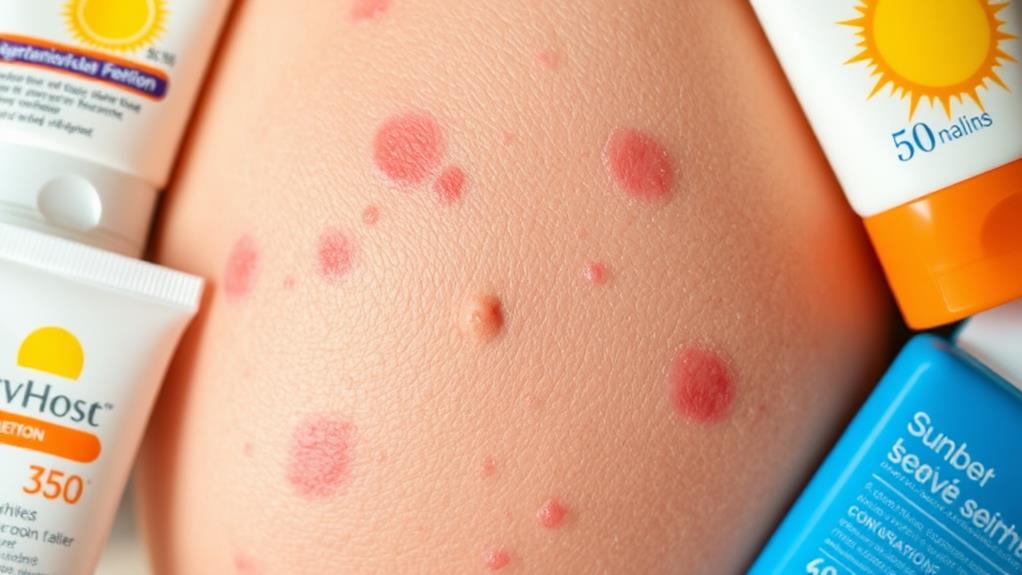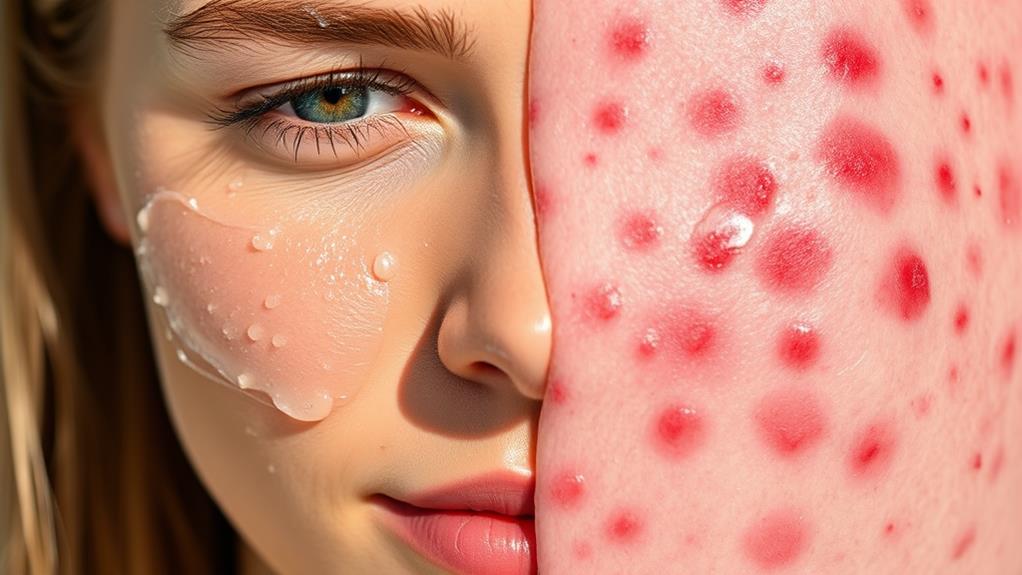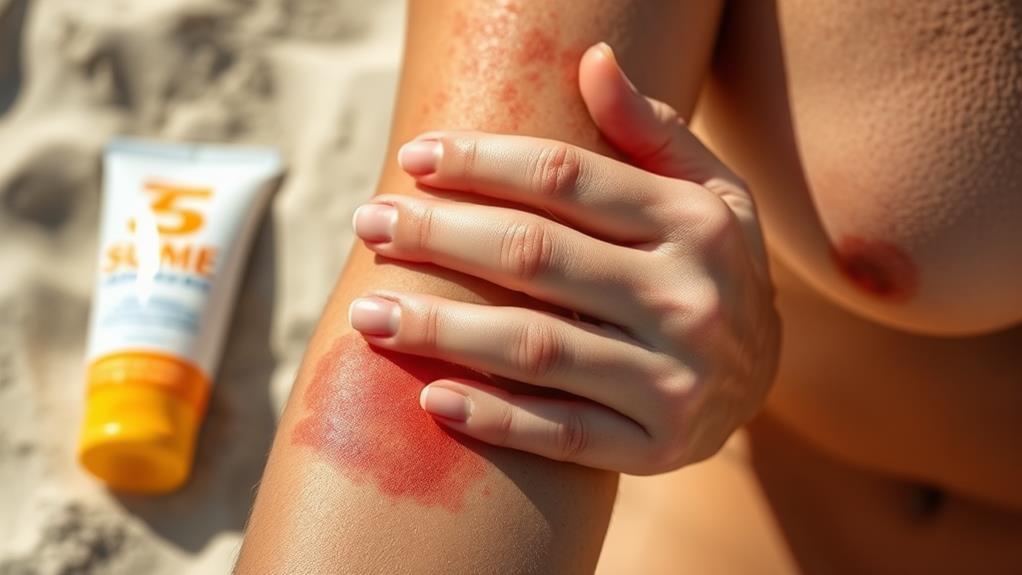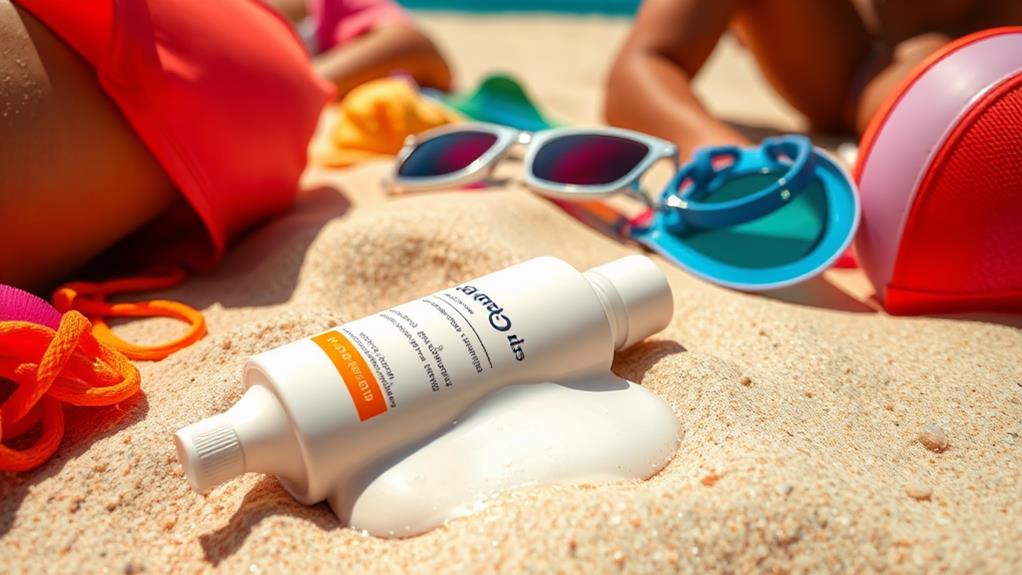You might think you're doing everything right by applying sunscreen daily, but there are side effects you may not even realize could affect you. From skin irritation and allergic reactions to unexpected acne breakouts, the impact of sunscreen isn't always as straightforward as it seems. Some products can even stain your clothes or disrupt your hormonal balance. Understanding these lesser-known effects is key to choosing the right protection for your skin. So, what should you be aware of before your next application?
Skin Irritation and Sensitivity

Experiencing skin irritation and sensitivity can be a frustrating side effect of using sunscreen. You might notice redness, dryness, or a tight feeling on your skin after applying it. This irritation is especially common if you have sensitive skin or are prone to allergic reactions.
Certain sunscreen ingredients can trigger these reactions, leading to discomfort that can make you rethink your sun protection routine. If you're applying sunscreen and find that your skin reacts badly, it might be time to check the ingredients list.
Some formulations, especially those containing aminobenzoic acid (PABA), can cause increased sensitivity or even stain your clothes. While some people may develop a tolerance over time, persistent symptoms like redness and dryness shouldn't be ignored. They're signals from your body that it may be wise to consult a healthcare professional.
Additionally, using the wrong sunscreen can lead to acne development or worsen existing acne conditions. Some sunscreens contain oils or heavy ingredients that clog pores, turning a sunny day into a breakout nightmare.
To avoid these issues, look for products labeled "non-comedogenic," which means they're less likely to cause acne.
Allergic Reactions
Allergic reactions to sunscreen can lead to uncomfortable symptoms that may appear shortly after application. You might notice skin sensitivity, irritation, or even rashes, which can show up as redness, itching, or hives.
These reactions often stem from certain sunscreen ingredients, with oxybenzone being a common culprit, along with octocrylene and various fragrances. If you have sensitive skin, you're especially at risk for these types of allergic reactions.
In some cases, a serious allergic reaction can occur, which may require immediate medical attention. Symptoms like swelling, difficulty breathing, or severe skin reactions are rare but can be alarming.
If you ever experience these symptoms, it's essential to stop using the product right away and consult a healthcare provider for guidance.
Before trying a new sunscreen, especially if you know you have skin sensitivities, consider patch testing. This involves applying a small amount of the sunscreen to a discreet area of your skin to see how your body reacts.
It's a simple way to identify potential allergens without risking widespread irritation.
Acne Breakouts

When you're picking out sunscreen, it's important to know that some ingredients can actually trigger acne breakouts.
If you have oily or acne-prone skin, certain formulations might trap oil and bacteria, leading to pesky pimples.
Plus, how you apply your sunscreen and your skin type can really affect whether you end up with a clear complexion or not.
Ingredients Causing Breakouts
Certain ingredients in sunscreen can lead to acne breakouts, especially if you have oily or acne-prone skin. Many sunscreens contain comedogenic ingredients, like certain oils and silicones, which can clog pores. This clogging often results in acne breakouts.
Chemical sunscreens may include ingredients like octinoxate and homosalate, which can cause skin reactions and even allergic reactions, worsening existing acne conditions.
If you have sensitive skin, watch out for synthetic fragrances and preservatives, as these can provoke inflammation and lead to breakouts. Although mineral sunscreens with zinc oxide or titanium dioxide are typically less irritating, formulations with heavy oils or thick textures can still contribute to issues.
To guarantee skin protection without the risk of acne, look for non-comedogenic labels on sunscreen products. These are specifically designed not to clog pores. Additionally, performing a patch test before applying a new sunscreen can help you avoid adverse skin reactions.
Application Technique Issues
Applying sunscreen improperly can lead to acne breakouts, especially if you're using products with heavy oils or comedogenic ingredients. If your application technique involves slathering on too much product, you might end up with clogged pores, which can cause those annoying pimples and blackheads.
To keep your skin clear, it's best to choose non-comedogenic sunscreens specifically designed for oily skin.
When you apply sunscreen, make sure it's even and not too thick; an overly thick layer can trap sweat and bacteria, increasing your chances of breakouts. Remember, a little goes a long way!
After sunscreen application, always cleanse your skin regularly to remove any product residue that could linger and contribute to flare-ups.
If you're prone to acne, pay attention to how you apply your sunscreen. A careful, light application can help you enjoy the sun without the unwanted side effects.
Skin Type Sensitivity
Experiencing acne breakouts can be frustrating, especially when using sunscreen. If you have oily or acne-prone skin, certain sunscreen ingredients might clog your pores, leading to unwanted breakouts.
Chemical sunscreens, particularly those with oxybenzone and octinoxate, can cause skin irritations and exacerbate acne more than mineral options like zinc oxide or titanium dioxide.
A study revealed that up to 6% of sunscreen users reported breakouts as a side effect. That's why it's crucial to choose non-comedogenic formulations, which are designed not to block pores.
Heavy oils and silicones in some sunscreens can worsen acne in sensitive skin types. Instead, look for lightweight, oil-free products that won't add extra shine or clog your pores.
Before applying a new sunscreen, consider patch-testing it on a small area of your skin. This simple step can help you identify potential irritants and reduce the risk of flare-ups.
Discoloration and Staining
Sunscreen can leave its mark not just on your skin but also on your clothes, leading to frustrating discoloration and staining. Many people don't realize that certain sunscreens, especially those containing aminobenzoic acid (PABA), can cause permanent marks on fabrics if not treated quickly.
When you apply chemical sunscreens and then sweat, the combination can lead to unsightly discoloration on both your skin and clothing, particularly in areas where you've applied the product heavily.
Another culprit in the staining game is synthetic dyes or fragrances found in some sunscreens. These ingredients are likely to cause problems on lighter fabrics, resulting in stains that can be tough to remove.
Improper application can also exacerbate the issue. If you use too much sunscreen or don't allow it to dry before getting dressed, you might find yourself dealing with unintentional marks on your favorite outfit.
To avoid this predicament, it's wise to apply your sunscreen at least 30 minutes before dressing. This gives the product time to soak in and reduces the risk of contact with your clothing.
Consider using mineral-based sunscreens, which tend to be less likely to cause fabric discoloration. By taking these simple steps, you can enjoy sun protection without the worry of unsightly stains marring your wardrobe.
Burning or Itching Sensations

When using sunscreen, you might notice burning or itching sensations on your skin.
These reactions can happen due to sensitivity to certain ingredients or improper application.
If you experience discomfort, it's best to stop using that product and consider a patch test for new sunscreens to find one that suits you better.
Common Allergic Reactions
Burning or itching sensations can be alarming signs of an allergic reaction to sunscreen, especially for those with sensitive skin. If you experience these symptoms, it's crucial to pay attention, as they might indicate common allergic reactions.
Ingredients like oxybenzone and octinoxate are often linked to skin allergies, causing redness, swelling, and discomfort.
You might also find that some sunscreens contain fragrances and preservatives that can trigger irritation, even in products labeled for sensitive skin. It's a bit ironic, isn't it? You think you're choosing something gentle, but allergens can still sneak in.
To stay ahead of potential issues, monitor your skin for early signs of irritation, like localized redness or itching, right after applying sunscreen. If you notice any discomfort, it's best to discontinue use immediately.
And remember, if these reactions persist, seeking medical advice is a smart choice. Your skin deserves the best care, so don't hesitate to consult a professional who can help determine the cause and suggest safer alternatives.
Staying informed about your options can make all the difference in enjoying the sun safely!
Ingredient Sensitivity Issues
After applying sunscreen, you might notice an uncomfortable burning or itching sensation on your skin. This reaction could be due to ingredient sensitivity, particularly to specific active ingredients like oxybenzone or fragrances found in many formulations.
Some chemical filters, such as octinoxate and avobenzone, can also cause allergic reactions, leading to skin irritation, redness, and that pesky burning sensation.
If you have sensitive skin or a history of skin allergies, it's crucial to be cautious. Alcohol-based formulations can further irritate, causing itching or burning, especially if your skin is already delicate.
To minimize these risks, consider performing a patch test before applying a new sunscreen all over your body. This simple test can help you determine how your skin reacts to the product.
Improper Application Effects
Improperly applying sunscreen can lead to uncomfortable sensations on your skin, like burning or itching. When you apply sunscreen too thickly or unevenly, it can create an irritating layer that doesn't protect you properly. Ingredients like aminobenzoic acid, often found in some sunscreens, might cause skin irritation, leading to those annoying sensations.
If you have sensitive skin, you're especially at risk, as certain chemical filters can worsen reactions from improper application.
You also need to remember to reapply sunscreen regularly, especially after swimming or sweating. Failing to do so can leave your skin unprotected, increasing the chance of sunburn and subsequent itching.
If you start feeling burning or itching after applying sunscreen, it's a good idea to discontinue use right away. These symptoms could indicate an allergic reaction or sensitivity to certain ingredients in the product.
In such cases, consulting a healthcare provider is the best course of action. They can help you find a sunscreen that suits your skin type and keeps you safe from the sun without discomfort.
Hormonal Disruption Risks
The potential hormonal disruption risks associated with certain sunscreen ingredients, like oxybenzone and homosalate, raise important concerns for users.
Oxybenzone, a common chemical in many sunscreens, has been linked to lower testosterone levels in boys and has even been implicated in adverse reproductive outcomes in females, such as endometriosis. When you apply sunscreen, there's a chance of systemic absorption, meaning these chemicals can enter your bloodstream.
Studies have found detectable levels of oxybenzone not just in blood but also in breast milk, which raises questions about its long-term effects on hormonal health.
Homosalate is another ingredient that deserves attention. It's shown to disrupt endocrine function, which is critical for maintaining hormonal balance in your body. This disruption can lead to various issues, including allergic reactions that complicate its safety profile.
Given these risks, regulatory bodies like the European Commission have started flagging concerns about the safety of these ingredients at their current concentrations. They suggest we need more research on their potential hormonal effects.

